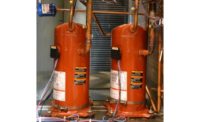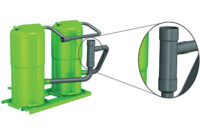Compressors Efficiently Evolve With Time

Compressors have followed the pattern of the HVAC industry with an increased focus on energy efficiency in recent years. (Photo courtesy of Emerson Climate Technologies.)

The biggest change in compressors over the last 25 years has been the movement from reciprocating compressors to those with scroll technology, said Karl Zellmer of Emerson Climate Technologies.


While various aspects of HVACR technology seem to be lagging behind, compressors are keeping pace. And, of all the compressors being introduced, manufacturers are ensuring new offerings meet demands, operate intelligently, and, perhaps most importantly, perform efficiently.
“The biggest trend is toward efficiency,” said Doug Schmidt, commercial sales manager, Embraco North America. “Producing the same amount of cooling for less power input, that’s going to be the biggest challenge we have and we continue to push that every day.”
Manohar Reddy, director of strategy and strategic marketing at Danfoss, said performance and efficiency are the top trends driving the market right now.
“Because buildings represent 40 percent of total U.S. energy consumed, and those costs have increased significantly, there is a demand for more energy-efficient air conditioning systems,” Reddy said. “And that demand drives OEMs, equipment manufacturers, and compressor manufacturers to focus on the technology to improve the efficiency of the compressors.”
Reddy acknowledged that over the last two decades the industry has made great strides regarding technology, efficiency, and reliability.
“One of the key developments has centered on variable-speed technology, which offers higher turndown ratios with linear modulation exactly matching building loads, thereby improving efficiency and overall performance.”
Karl Zellmer, vice president of air conditioning sales at Emerson Climate Technologies, also cited increased efficiency as a difference maker.
“The biggest change in compressors has been a tremendous improvement in energy efficiency driven by changing regulation requirements and customer needs. And that is what we have been able to deliver,” he said.
Scrolling Forward
While energy efficiency is on everybody’s mind, David Hawkes, director of engineering, North America, at Tecumseh Products Co., said the biggest change in compressors has been the shift toward more rotating technologies.
“The rotating technologies have become a dominant player in the air conditioning side of the business where rotaries and scrolls have taken over basic window air conditioning on up to residential and light commercial air conditioning,” he said.
David Sylves, director of inside sales and marketing, Bitzer U.S. Inc., also recognized the proliferation of scroll compressors.
“Over the past 20 years, scroll compressors have become the dominant compressor technology for residential and light commercial a/c applications,” Sylves said. “Screw compressors have replaced large reciprocating compressors in commercial chillers and rooftop a/c systems. Semi-hermetic reciprocating compressors remain the best technology for refrigeration applications.”
The movement from reciprocating technology has been significant, noted Zellmer.
“The biggest single change has been the move to scroll technology over the last 25 years,” Zellmer said. “I’m proud to have been a part of it and see that transition take place. And I saw not only a change in the technology, but also saw scroll technology evolve to be able to adapt to different size requirements, displacements, applications, significant efficiency improvements, and also adapt to changing market conditions.”
The biggest change, from Schmidt’s perspective, was the introduction of the variable-speed compressor. “That introduced some electronic intelligence to the compressor so it can operate in a reactive way, independent of any other control scheme. It can sense refrigeration load and adjust its speed and performance to that load rather than the old mentality of ‘on’ or ‘off,’” Schmidt said.
Scroll technology has transformed the air conditioning industry, Reddy said, noting that, in Japan, where utility costs are much higher, nearly all compressors use variable-speed technology.
But, with energy consumption and utility costs increasing in the U.S., variable-speed technology is an enabling solution for the smart grid with demand response capabilities for controlling peak load, Reddy said.
Amidst the technological expansion, Hawkes still believes reciprocating technology will possess a valuable place in many industry sectors for several years.
“We also have rotaries and scrolls, but I think the most significant thing for our particular market and customers is green refrigerants and things like that,” he said.
Sylves agreed that green refrigerants are growing in demand. “Ecological considerations are driving the industry toward the use of more natural refrigerants,” he said. “Ammonia, CO₂, and HCs are being applied to more and more systems.”
Bristol Compressors recently released its H7 Series model of compressor, which is approved for retrofit in existing R-22 systems using R-407C or R-22 refrigerants.
The H7 Series models are charged with POE oil and are available in 1.5-ton through 5-ton capacities. “The ease of compressor changeout allows an R-22 system to continue in service for the remainder of its useful life,” said Barry Rust, director of marketing, Bristol Compressors, in a press release. “This gives our valued contractors an environmentally friendly, industry-compliant, lower-cost re-placement and repair option as they work on R-22 systems.”
Planning for the Future
Manufacturers are constantly looking to stay on top of the latest technologies, but as of now, most aren’t forecasting any major shift in how compressors run and work in the near future.
“Bitzer’s research and development department constantly evaluates new technologies and concepts for possible game-changing inventions that can impact the design or operation of compressors,” Sylves said. “As of this writing, we do not anticipate any radical shifts in the way compressors operate.”
Zellmer said Emerson does its best to stay one-step ahead when it comes to future products and innovations in order to remain on the cutting edge of technology.
“One of our key strengths is we stay very close to our OEM customers and the proposed regulation changes as they’re being discussed in Congress. If you plan well ahead, discuss them with your customer base, and together with them, achieve a better understanding of what is needed to support and achieve those changes in the industry, then it’s more of an opportunity than an issue. You just need to make sure your products meet the needs and are available well ahead of time.”
With variable-speed compressors making an impact and oil-free compressors beginning to grow, a compressor remains at the core of an air conditioning unit. Going forward, many acknowledge that these two budding technologies will continue to largely influence compressor development. “I think the biggest focus for a lot of people will be cost-effective drives and controls,” Hawkes said. “Even though we move slowly, I think the trend will be toward variable speed and variable capacity for efficiency reasons. I think the growth in that segment of the market is going to be based on doing it cost effectively.”
Although compressors might not be changing too much in nature, there are definitely things behind the scenes that are changing the way compressors are made.
“We don’t see a radical shift in the near future, but we do believe there are some common customer needs we’re going to continue to address,” Zellmer said. “Those would be energy efficiency, reliability, communications, and comfort. These are the drivers for innovation. In addition, there will be a need for even more earth-friendly HVAC solutions, and that will drive research and development for compressors designed for new refrigerants and even further increases on energy efficiency.”
Publication date: 3/25/2013










